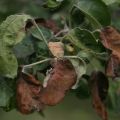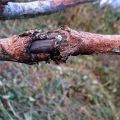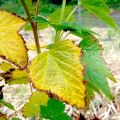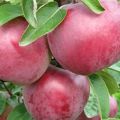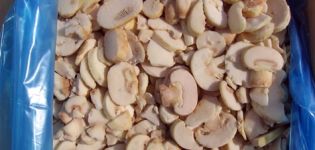Why do individual branches dry on an apple tree and what to do to heal the tree
There are several reasons why an apple tree can dry in summer. Gardeners often face such a problem when the green crown suddenly begins to turn yellow and dry. If you do not find out the reason in time and do not take action, then the tree may die. Among the main adverse factors are pests and diseases, a lack of nutrients in the soil, a lack or excess of moisture.
The main reasons for the drying up of the apple tree
Withering and drying of leaves with branches on an apple tree can occur for many reasons. The main adverse factors include:
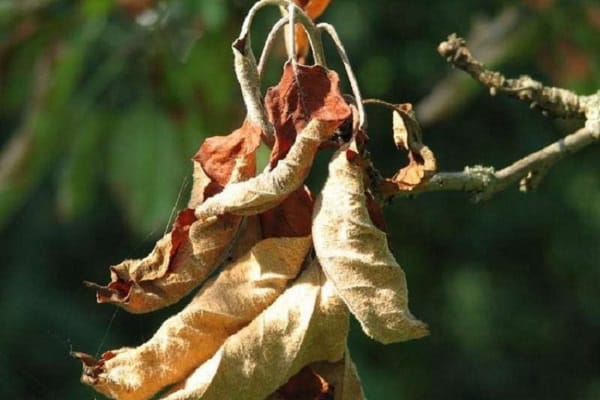
- improper care and violation of agrotechnical practices;
- attack of insect pests;
- infection with various infections;
- lack of trace elements in the soil (lack of fertilizing).
The tree cannot dry out quickly. This happens over several seasons, so considerate gardeners can save the tree by identifying the cause and taking appropriate action.
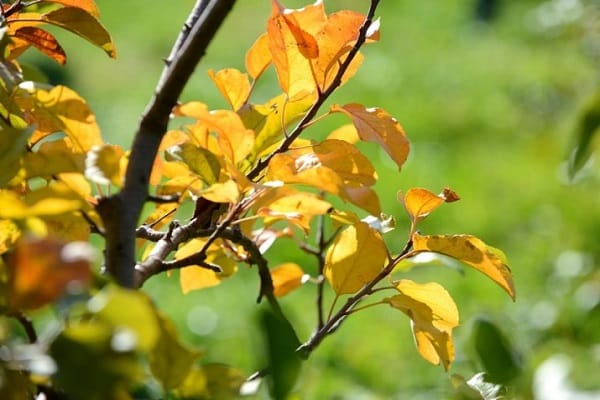
Saplings
Often, the branches and leaves of a young apple tree begin to dry and fall off. This can happen for the following reasons:
- Soil that is not suitable for the growth of an apple tree leads to the fact that the leaves wither, dry out and fall off. Do not plant trees in soil with a large amount of small stones. Clay and sandy soil composition is poorly suited.
- Saplings may die due to poor neighborhood. The root system of other plants does not allow the roots of the apple tree to develop.
- It is imperative to observe the timing of planting seedlings. Planting is carried out in spring and autumn in prepared soil. Planted trees often do not develop further in summer.
- The foliage of the seedling reacts to hot weather. Therefore, dry, hot air becomes the cause of foliage falling in summer.
Shoots of a recently planted seedling may dry out due to a lack or excess of moisture, as well as improper feeding.

Young trees are drying
If a young apple tree, which has not yet turned 5 years old, has begun to dry, urgent measures must be taken. They are most vulnerable to adverse environmental factors and improper care:
- Young trees already have a sufficiently formed root system that spreads over long distances. If groundwater passes close underground, then the supply of oxygen is disrupted, and root decay also occurs.The tree stops growing, sheds foliage, and the number of crops is significantly reduced.
- If you do not carry out periodic thinning and loosening around the young apple tree, then some weeds and grasses can interfere with its development.
- Improper treatment with pest and disease control products can lead to burns. Their excessive use or non-observance of the proportions during the dilution of the solution leads to the fact that leaves, bark, and shoots are damaged.
Young, immature trees often die due to the attack of various pests and infection with diseases. Young roots often eat beetle larvae.

Mature fruit trees
Apple trees, which have given a rich harvest for many years, can also suddenly begin to dry out and die. There are several reasons for this:
- too cold winter and trees not prepared for wintering (the trunks are wrapped for the winter so that cracks do not form);
- due to the proximity to other adults, powerful fruit trees, the apple tree does not receive nutrients, and the crown dries up;
- improper pruning of branches leads to a weakening of the apple tree, and if you do not process the cut site, the risk of disease attachment increases;
- in order to be vaccinated, knowledge and skills are needed, therefore, an incorrectly performed procedure also causes drying.
In the most mature apple trees on the site, immunity decreases, and they weaken, therefore, more often than others, they are attacked by pests and become infected with infectious diseases.
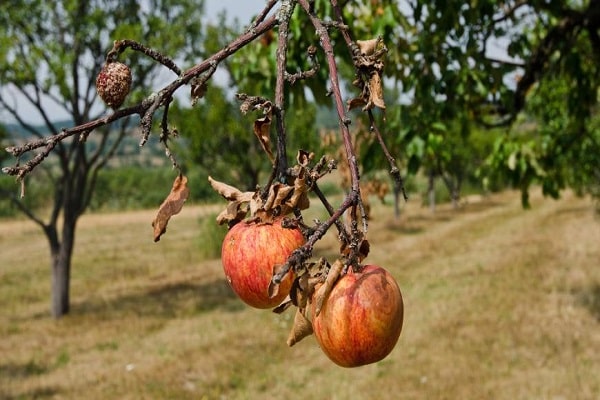
Influence of heat and dry conditions in summer on an apple tree
Climatic conditions can cause the crop to dry out. Especially often the problem arises in the southern regions, when the air temperature in June or July is above +30 degrees. Hot air and direct sunlight contribute to the rapid evaporation of moisture from the surface of the leaves, and they begin to dry.
Characteristic signs
Signs of drying out of different parts of the apple tree appear in different ways. Only the leaves of one part of the tree or only the top can dry out. The reasons may be associated with unfavorable climatic conditions, improper care, diseases and pests.
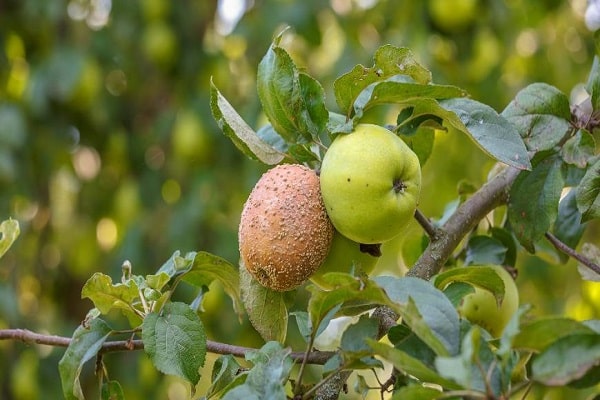
On the leaves
Due to improper care, branches and leaves dry out on only one side of the tree. This happens due to the lack of timely fertilizing, planting powerful shrubs next to the tree, not loosening and weeding the soil around the trunk. The edges of the leaves begin to dry, yellow spots appear.
On the branches
The tips of the branches of the apple tree dry out due to damage to the roots, infection with diseases, excessive waterlogging of the soil or improper grafting. Young branches begin to dry from the top. The reason may be related to a lack of potassium in the soil.
If only individual branches die and the edges of the leaves dry, then groundwater is passing nearby. The roots that have reached the water begin to rot. As a result, branches and leaves dry out.
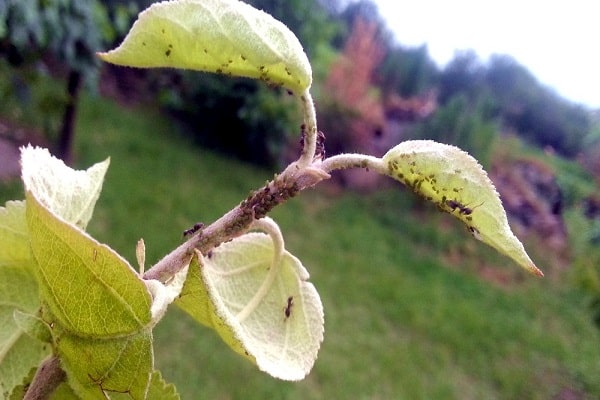
On the trunk
In most cases, the trunk and bark begin to dry out as a result of a fungal infection or black cancer on the tree. The bark darkens, growths appear, it is easily separated, exposing the trunk.
On flowers
Problems can arise during the flowering of the apple tree. Flowers dry up and fall most often as a result of disease or lack of mineral components. Therefore, as soon as the buds appear, it is recommended to spray with such preparations as "Zircon", "Epin". When the flowers bloom, they are sprayed with the preparations "Bud", "Ovary".
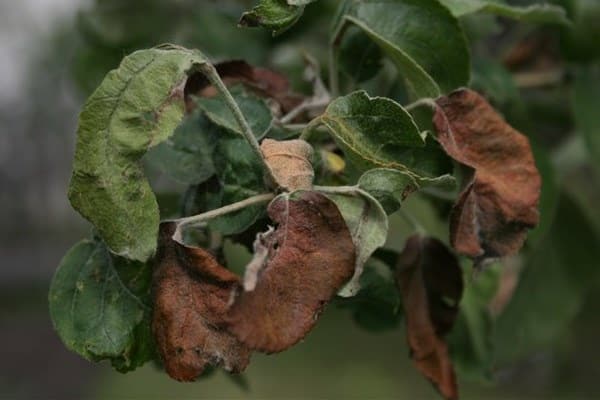
On the fruits
If the branches dry with the apples, the cause is associated with some kind of disease. Most often it is brown rot. Brown spots appear on the fruits, which spread quickly. Apples dry up and fall off before reaching full ripeness.
Anti-drying agents
The set of measures aimed at saving a sick tree depends on the reasons that led to the yellowing and drying of the crown. It is possible to save the culture with solutions prepared on the basis of purchased drugs, or folk remedies.
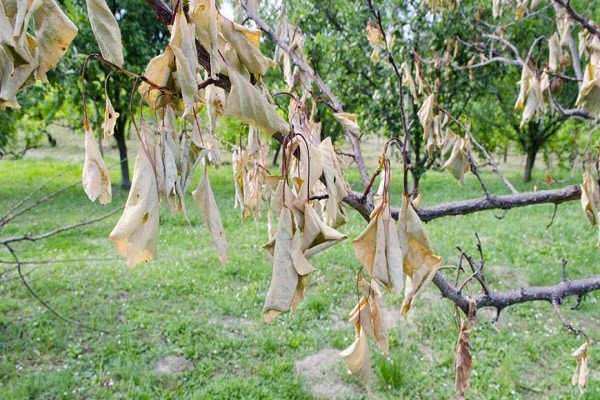
Associated with apple disease
If the apple tree has been attacked by pests or is sick, then, in addition to drying out the leaves and branches, there are other signs:
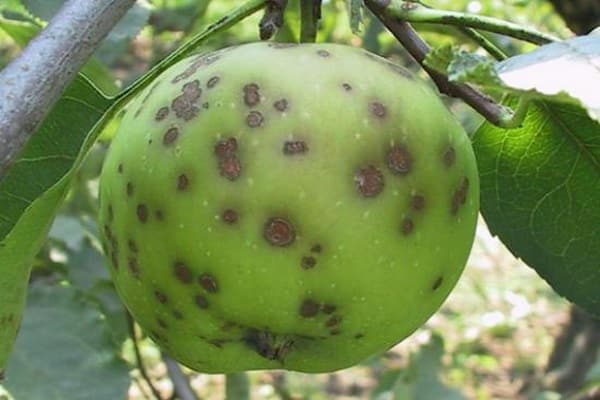
- Cytosporosis is a common disease that in most cases affects old apple trees. The bark and branches dry out, dark growths form on the trunk and on the fruits.
- Black cancer disease is difficult to treat. The fight lies in the timely removal of diseased branches. Black spots and stripes appear on the leaves. After a while, whole branches dry out.
- The scab causes brown spots on the leaves. As the disease progresses, the leaves dry out and fall off.
- Powdery mildew appears as a grayish-white bloom on the buds and leaves of the tree. A fungal disease that appears during the flowering stage leads to the fall of flowers and ovaries.
The means of combating diseases include autumn treatment with copper sulfate, annual spraying of trees with Bordeaux liquid or preparations "Hom", "Abiga-Peak", "Skor", "Topaz", "Vectra".

Unrelated to disease
Be sure to provide a fruit crop with proper care:
- If the soil is excessively wet, it is better to transplant the tree to another place or drain the soil.
- With a lack of moisture on dry, hot days, regular and abundant watering is carried out.
- Periodically weed and loosen the soil around each fruit tree.
If the cause of the drying out of the tree was not a disease, it is easier to cope with the problem:
- If the tree dries up due to freezing after winter, it is recommended to irrigate with warm water with the addition of nutrients.
- If underground waters pass through the entire site, and there is no way to transplant seedlings, then it is necessary to maintain a small size of trees. The root system will not feel a strong load, and the apple tree will develop further.
- Heteroauxin solution will help to heal wounds after pruning.
- A perennial tree dries for natural reasons, in order to prolong the life of an apple tree, feeding and removing old, dry branches will help.
If all agrotechnical methods are observed, it is possible to restore the culture quickly. If the cause is not eliminated in time, the quality and quantity of the crop will decrease.
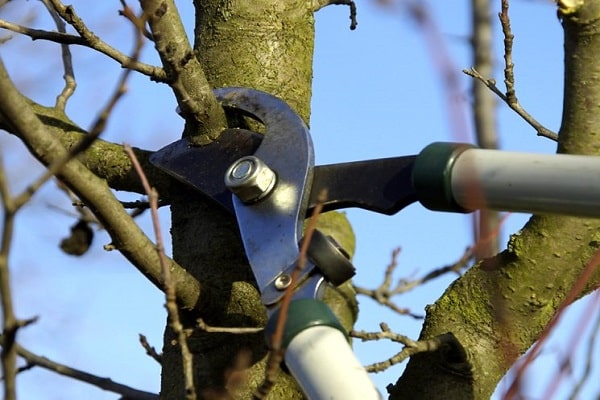
When to start rescue efforts
The fight against drying begins immediately after the detection of the problem, in order to prevent the complete death of the culture. The slowdown leads to a decrease in yield and death of the fruit tree.
Timing
Trees processing begins in March and continues until late autumn:
- In spring, trees are processed to prevent the appearance of pests and diseases. Places are processed after pruning old and diseased branches.
- In the summer, they organize the correct processing of the soil with fertilizers and moisture.
- In the autumn, a fruit tree is prepared for wintering.
None of the steps in crop care should be missed. This will reduce the chances of drying out on various parts of the tree.
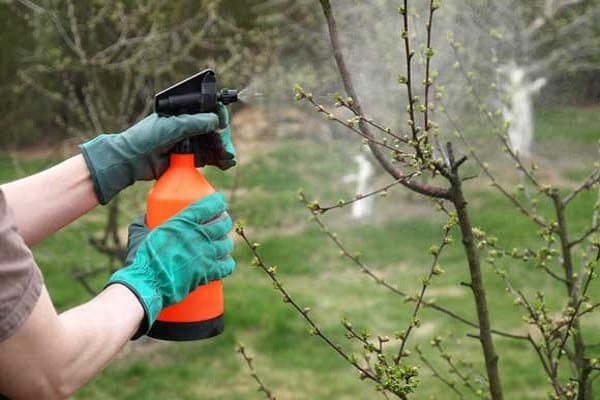
Processing technology
In most cases, diseases and pests cause the tree to dry out. The processing of apple trees is carried out according to a certain scheme, which will not allow an oversupply of pesticides:
- Before the buds swell, in order to get rid of hibernating pests, the first spraying with a urea solution is carried out.
- To protect the buds from pests, treatment is carried out with drugs such as "Skor", "Horus", Bordeaux liquid.
- After flowering, spraying is carried out with such preparations as "Marshal", "Nurel", "Neoron".If the treatment is carried out for prophylactic purposes, then the solution is prepared using less safe drugs: Fitoverm, Barrier, Aktofit.
- In the summer, it is enough to apply fertilizers, which will increase the crop's resistance to many unfavorable factors.
- In the autumn, spraying is carried out for preventive purposes, using the drug "Skor" or Bordeaux liquid.
In the summer, when the fruits begin to ripen, it is impossible to use chemical preparations.

Timely watering and fertilization
To apply fertilizers around the apple tree, pits are made 6 cm deep. Nutrients are laid in them. In July, it is better to use nitrogen, and in August, phosphorus and potassium.
Fresh manure cannot be used as fertilizer. It is more useful to dissolve the component in a bucket of water and pour the resulting solution around the trunk. To increase the benefits, superphosphate is added to the solution.
To cultivate the land around the apple tree, you need only settled, warm water. The first watering is carried out immediately after flowering, then during the formation of fruits. The last watering is carried out at the end of August. After each watering, it is recommended to loosen the soil.
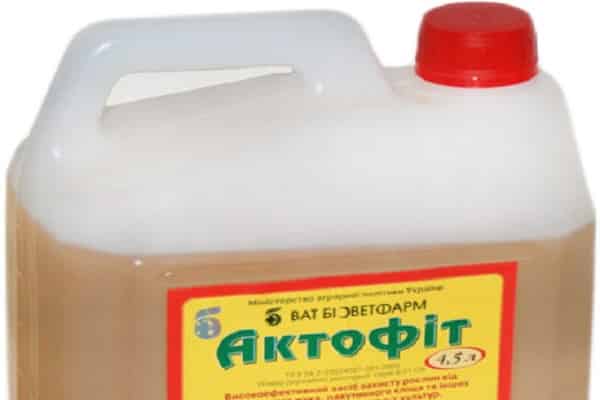
Prevention
Prevention consists in observing the rules for caring for a fruit crop:
- Fallen leaves and cut branches should be taken away from the site or burned. They cannot be used as mulch.
- After trimming, the cut is processed with special solutions.
- Particular attention is paid to preparing the apple tree for winter. The soil around the trunk is mulched, and the trunk itself is covered. After snow falls, a large snowdrift is formed at the trunk.
- Fertilization is carried out periodically.
- In the spring, two treatments with fungicides are carried out.
Folk remedies used when caring for an apple tree are safe and effective, especially for preventive purposes. Therefore, preventive recommendations must be followed to prevent the development of problems.



